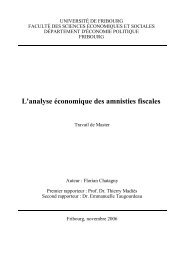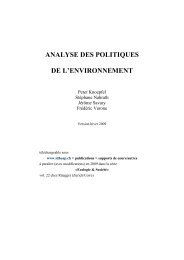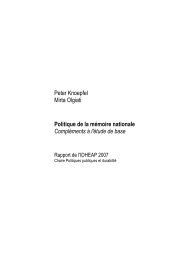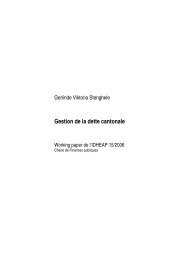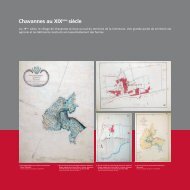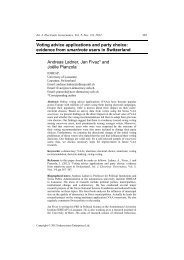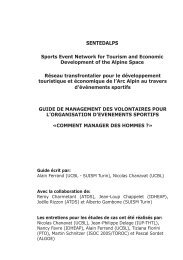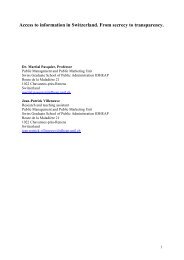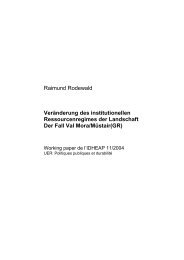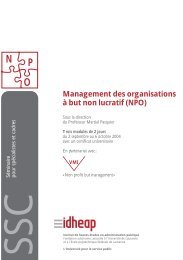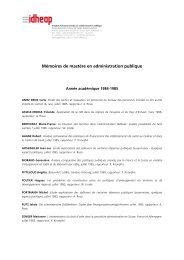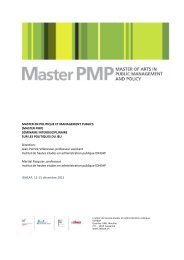Historical Analysis of Institutional Regimes in Switzerland ... - IDHEAP
Historical Analysis of Institutional Regimes in Switzerland ... - IDHEAP
Historical Analysis of Institutional Regimes in Switzerland ... - IDHEAP
You also want an ePaper? Increase the reach of your titles
YUMPU automatically turns print PDFs into web optimized ePapers that Google loves.
15<br />
the environmental legislation <strong>in</strong> the early 1980s, protection <strong>of</strong> biotopes was developed and riparian<br />
sites, reeded areas, moors and rare forest societies were viewed as particularly worthy <strong>of</strong> protection.<br />
With the adoption <strong>of</strong> the <strong>in</strong>direct counterproposal to the Rothenturm Initiative, biotopes <strong>of</strong> national<br />
significance were <strong>in</strong>tegrated <strong>in</strong>to the Federal Law on the Conservation <strong>of</strong> Nature and Habitats.<br />
Article 18a provided the basis on which the upland moor, lowland moor and alluvial sites decree<br />
were later enacted. The <strong>in</strong>tention was to ensure the protection and ma<strong>in</strong>tenance <strong>of</strong> biotopes by<br />
means <strong>of</strong> agreements with and compensation <strong>of</strong> land owners.<br />
The adoption <strong>of</strong> the Rothenturm Initiative brought about further <strong>in</strong>tensification <strong>of</strong> measures for the<br />
protection <strong>of</strong> moors. There is now an absolute ban on changes to moor landscapes <strong>of</strong> national<br />
significance and particular beauty.<br />
Moreover, the protection and use policy formulated on the level <strong>of</strong> landscape components such as<br />
water, forests, agriculture etc. is an <strong>in</strong>direct impact <strong>of</strong> the legislation. In addition to the <strong>in</strong>troduction <strong>of</strong><br />
more str<strong>in</strong>gent protection policies, <strong>in</strong> some cases there has also been a shift <strong>in</strong> the focus <strong>of</strong><br />
regulations, <strong>in</strong> that the owners' use rights are not merely restricted but obligations (remunerated and<br />
non-remunerated) have been imposed with respect to renatur<strong>in</strong>g, measures to ma<strong>in</strong>ta<strong>in</strong> the landscape<br />
and compensatory services established (based on the model <strong>of</strong> forestry legislation).<br />
IR type: We def<strong>in</strong>e the landscape IR as simple to complex as despite the fact that differentiated<br />
<strong>in</strong>struments and objects <strong>of</strong> protection have emerged over the decades, a certa<strong>in</strong> one-dimensionality<br />
exists with respect to the protection/conservation <strong>of</strong> biotopes and landscape. The regime is<br />
determ<strong>in</strong>ed by landscape policy design and the regulations govern<strong>in</strong>g the legal ownership <strong>of</strong> other<br />
resources. It is an <strong>in</strong>direct regime which due to the lack <strong>of</strong> a tangible object starts with the authorities<br />
responsible for the resource soil as opposed to appropriators and users.<br />
b) Air (complex IR)<br />
Goods and services: The goods and services provided by the resource air <strong>in</strong>clude energy<br />
(<strong>in</strong>c<strong>in</strong>eration processes and w<strong>in</strong>d energy), raw materials production (for <strong>in</strong>dustry), pollutants s<strong>in</strong>k<br />
(absorption), support for transport (air traffic, radio waves, telephone), protection and <strong>in</strong>sulation<br />
(temperature and radiation <strong>in</strong>sulation layer, means <strong>of</strong> livelihood for people, animals and plants),<br />
leisure (health resorts, spas) and freedom (w<strong>in</strong>d sports, tourism).<br />
Property rights: In terms <strong>of</strong> private law, air belongs to the res communes omnium and is, hence,<br />
withdrawn from ownership. Air is not property (<strong>in</strong> accordance with the def<strong>in</strong>ition <strong>in</strong> the Swiss Civil<br />
Code): it is neither delimited nor tangible. The direct reference to air <strong>in</strong> the Civil Code concerns the<br />
respective <strong>in</strong>terests <strong>of</strong> neighbours (Article 684 Swiss Civil Code) and stipulates that land owners<br />
must refra<strong>in</strong> from uses which produce environmental impacts or immissions that affect their<br />
neighbours (e.g. smoke, bad smells). It should be noted that certa<strong>in</strong> cantonal clean-air regulations<br />
have - <strong>in</strong> part - adopted this right <strong>of</strong> neighbours to undisturbed co-existence. However, this pr<strong>in</strong>ciple<br />
has not yet been significantly expanded (for example <strong>in</strong> the aftermath <strong>of</strong> the Chernobyl disaster) and<br />
air merely features here as the landowners’ medium <strong>of</strong> action. Moreover, air space merely plays the<br />
role <strong>of</strong> a complement to a landowner’s area <strong>of</strong> dom<strong>in</strong>ion <strong>in</strong> terms <strong>of</strong> the three-dimensional extension<br />
<strong>of</strong> land ownership (Article 667, Paragraph 1 Swiss Civil Code). F<strong>in</strong>ally, a system <strong>of</strong> emissions<br />
certificates, which was <strong>in</strong>troduced on an experimental basis <strong>in</strong> the cantons <strong>of</strong> Basle-Town and Basle-<br />
Country, does not create a comprehensive and absolute property right for air but only the right to use<br />
the air <strong>in</strong> a certa<strong>in</strong> way, namely as a pollutant dump.



